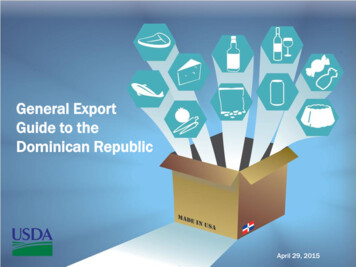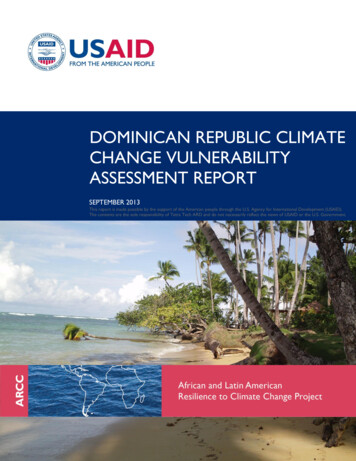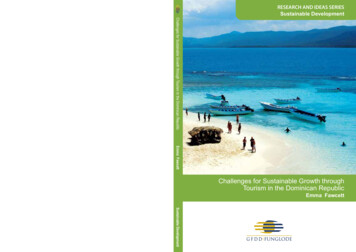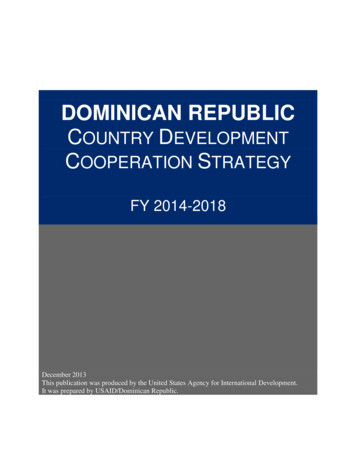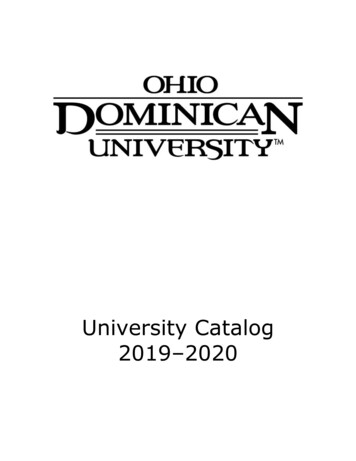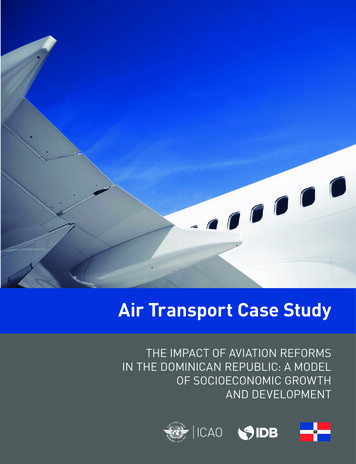
Transcription
WP/07/63Growth in the Dominican Republic and Haiti:Why has the Grass Been Greener on OneSide of Hispaniola?Laura Jaramillo and Cemile Sancak
2007 International Monetary FundWP/07/63IMF Working PaperWestern Hemisphere DepartmentGrowth in the Dominican Republic and Haiti:Why has the Grass Been Greener on One Side of Hispaniola?Prepared by Laura Jaramillo and Cemile Sancak1Authorized for distribution by Andy WolfeMarch 2007AbstractThe Dominican Republic and Haiti share the island of Hispaniola and are broadly similar interms of geography and historical institutions, yet their growth performance has divergedremarkably. The countries had the same per capita real GDP in 1960 but, by 2005, theDominican Republic’s per capita real GDP had tripled whereas that of Haiti had halved.Drawing on the growth literature, the paper explains this divergence through a combinedapproach that includes a panel regression to study growth determinants across a broad group ofcountries, and a case study framework to better understand the specific policy decisions andexternal conditions that have shaped economic outcomes in the Dominican Republic and Haiti.The paper finds that initial conditions cannot fully explain the growth divergence, but ratherpolicy decisions have played a central role in the growth trends of the two countries.This Working Paper should not be reported as representing the views of the IMF.The views expressed in this Working Paper are those of the author(s) and do not necessarily representthose of the IMF or IMF policy. Working Papers describe research in progress by the author(s) and arepublished to elicit comments and to further debate.JEL Classification Numbers: O11, O47, O57Keywords: Growth, income divergence, Dominican Republic, HaitiAuthor’s E-Mail Address: ljaramillomayor@imf.org; csancak@imf.org1The authors would like to thank Guy Meredith, Jeromin Zettelmeyer, and Andy Wolfe fortheir encouragement and support. We also thank Dan Holmes, Juan Climent, Chris Towe, LuisCubeddu, and participants at the WHD departmental seminar and WHD growth workshop fortheir useful comments. Volodymyr Tulin provided valuable research assistance.
2Table of ContentsI. Introduction . 4II. Literature Review. 5III. Initial Conditions . 5A. Geography. 6B. Historical institutions . 7IV. Analysis of Policies Pursued . 9A. Growth accounting. 9B. Empirical Endogenous Growth Model. 10Loayza, Fajnzylber, and Calderón (2005)—LFC Model. 12Improving the fit of the LFC model. 13Institutional quality . 13Macroeconomic stability. 15Panel regression . 17C. Growth Determinants . 17Dominican Republic . 19Haiti. 21V. Conclusions. 23Figures1. GDP per capita, and real GDP growth rates in Latin America.42. Population density.73. Settler mortality and ethnolinguistic fragmentation.84. Contribution to GDP per capita growth.105. Endogenous growth model.106. Actual vs. LFC projected changes in growth rates.137. ICRG institutions index.148. Magnitude of regime changes.149. LFC stabilization policies.1510. Indicator of macroeconomic instability.1611. Actual vs. LFC and JS projected changes in growth rates.1712. Dominican Republic: Changes in growth rates by component.1913. Trade openness.2014. Haiti: Changes in growth rates by component.21Tables1. Variables used in the LFC model.122. Results of panel regression on real per capita GDP.18
3Box1. Literature survey.11Appendices. 24I. Chronology of political events . 24Dominican Republic . 24Haiti. 26II. Variable definitions and sources . 28III. List of countries included in the panel regression . 30References. 31
4I. INTRODUCTIONThe Dominican Republic and Haiti present a quasi-natural experiment; the two countriesshare the island of Hispaniola and are broadly similar in terms of geography and historicalinstitutions, yet their growth performance has diverged remarkably since 1960. In 1960, theDominican Republic and Haiti had the same per capita real GDP at just below US 800.However, by 2005, the Dominican Republic’s per capita real GDP had tripled to aboutUS 2,500, whereas that of Haiti had halved to US 430 (Figure 1). Accordingly, theDominican Republic and Haiti have been at opposite ends of the spectrum within LatinAmerica and the Caribbean (henceforth LAC) in terms of growth rates over the past 45 years,with the Dominican Republic achieving one of the highest average real GDP growth rates atabove 5 percent and Haiti the lowest at about 1 percent (Figure 1).Figure 1. GDP per capita, and real GDP growth rates in Latin America, 1960-2005450045004000GDP per capita(in constant 2000 U.S. dollars)4000Latin America 8019902000Dominican Rep.PanamaBrazilCosta RicaEcuadorMexicoParaguayChileColombiaEl iAverage annualGDP growth(in percent)0123456Sources: WDI; and authors' calculations.What explains this divergence in per capita real GDP of the two countries? The paper seeksto answer this question by examining two main issues: (i) to what extent the divergence is theinevitable result of disparities in initial conditions, and (ii) to what extent it is the result ofdifferences in the policies pursued in each country since 1960. Drawing on the growthliterature, the paper addresses these issues through a combined approach that includes a panelregression to study growth determinants across a broad group of countries, and a case studyframework to better understand the specific policy decisions and external conditions thathave shaped economic outcomes in the Dominican Republic and Haiti. To examine policydecisions, the paper uses growth determinants from the literature and introduces alternativevariables of institutional quality and stabilization policies to help better explain the incomedivergence between the two countries. Furthermore, to facilitate comparisons, Latin Americais used as a reference point throughout the paper.When examining initial conditions, namely geography and historical institutions, we findgreat similarities between the Dominican Republic and Haiti, implying that initial conditionscannot explain their divergence in per capita real incomes. Moreover, based on the panel
5regression and case study, we find that policy decisions since 1960 have played a centralrole. In particular, the Dominican Republic has consistently outperformed Haiti and the restof Latin America in terms of structural measures and stabilization policies, while Haiti hasbeen subject to numerous political shocks that have severely affected its growth performance.The paper is structured as follows. Section II reviews findings in the growth literature on theDominican Republic and Haiti. Section III examines the initial conditions, in particulargeography and historical institutions. Section IV analyzes the policies pursued in the twocountries, framing the discussion by an empirical endogenous growth model. Section Vsummarizes the findings and concludes.II. LITERATURE REVIEWOnly a few studies have compared the growth performance of the Dominican Republic andHaiti, and these studies have provided mostly qualitative discussions. Among the well-knownis the chapter in Jared Diamond’s book “Collapse” (2005). Although Diamond focuses onenvironmental policies, it can be inferred from his arguments that higher population densityand lower rainfall have been the main factors behind the more rapid deforestation and loss ofsoil fertility on the Haitian side of Hispaniola, with adverse consequences for agriculturalproduction and therefore growth performance. Similarly, Lundahl (2001) argues that Haiti isthe poorest country in the western hemisphere because of the interplay between populationgrowth and the destruction of arable land. He explains that the increase in the rural laborforce has led to an expansion of subsistence food crops to the detriment of export crops, inthe context of decreasing international food commodity prices.Other studies have found that economic performance in the Dominican Republic has beenfavored by political and macroeconomic stability. Bulmer-Thomas (2001) finds that, for theCaribbean in general, improvements in per capita GDP are linked to higher exports percapita, the quality of institutions, and stability of the macroeconomic framework. The WorldBank (2006b) also argues that the Dominican Republic experienced a more enablingenvironment for private investment than Haiti due to political stability and stablemacroeconomic conditions over prolonged periods that allowed it to follow a morediversified and outward oriented growth strategy. In addition, IMF (2001) argues that growthin the Dominican Republic during the 1990s was anchored by capital formation and strongproductivity growth, while trade liberalization encouraged private investment and outputgrowth.III. INITIAL CONDITIONSWe examine two initial conditions that the growth literature highlights as the most likely toinfluence long-term growth performance: geography and historical institutions. While theabsence of national accounts prior to 1960 does not allow us to determine exactly at whatpoint in time the Dominican Republic started growing faster than Haiti, this analysis helps usdetermine if the divergence started long before 1960.
6A. GeographyGeography plays a direct role in shaping a country’s growth performance. It determines thequality of natural resources, the productivity of land, the public health environment, and theextent to which a country can become integrated with world markets. We find no substantialdifferences between the Dominican Republic and Haiti on these grounds, from which we caninfer that that geography cannot explain the growth divergence between the two countries. Gallup, Sachs, and Mellinger (1998) argue that: (i) tropical regions are hindered indevelopment relative to temperate regions; (ii) coastal regions are strongly favored indevelopment relative to the hinterlands; and (iii) high population density is favorable foreconomic development in coastal regions with good access to trade. However, thesefactors do not explain the divergence between the two countries as they have the samelocation, ocean access, and climate, while Haiti has historically had twice the populationdensity of the Dominican Republic.2 As explained in the literature review, Diamond (2005) argues that rapid deforestation,caused by lower rainfall and higher population density, has led to lower growth in Haiticompared to the Dominican Republic. However, a 1941 study on rainfall in Hispanioladid not find evidence that Haiti had lower rainfall than the Dominican Republic. Basedon data for an average of 11 years, the study reveals that rainfall was comparable in thetwo countries.3 Likewise, even if lower rainfall had in fact been an issue for Haiti, it didnot appear to be an obstacle to agricultural production in the 18th century when Haiti wasone of the richest colonies in the French empire.4 Moreover, deforestation on the Haitianside can be considered a more recent phenomenon as, even as late as 1960, the amount ofarable land in both countries was comparable at about 20 hectares per person.5 Diamond’s argument about population density runs contrary to cross-country evidenceabout the potential benefits of higher population density, such as that found by Gallup etal. (1998) and Klasen and Nestmann (2004) who argue that population density generatesthe linkages, infrastructure, demand, and effective market size for technologicalinnovations that fuel growth. Figure 2 illustrates the relationship between populationdensity and growth. Between 1960 and 2005, many of the countries with the highest per2Haiti is about half the size of the Dominican Republic, but has roughly the same population.3See Alpert (1941).4In the 1780s, Haiti, nicknamed the “Pearl of the Antilles”, produced about 40 percent of all the sugar and 60percent of all the coffee consumed in Europe.5Looking at GDP growth by sector over the period 1960-2000 reveals that performance of the primary sectordid not drive overall growth results in either country. In the Dominican Republic, the primary sector explainsabout 12.5 percent of the total average growth rate, while the secondary and tertiary sectors explain 32.5 percentand 55 percent respectively. Similarly, in Haiti, the primary sector explains less than 10 percent of the totalaverage growth rate, while the secondary and tertiary sectors explain about 45 percent each.
7capita real GDP growth had high population densities—in some cases even higher than inHaiti—while countries with the lowest per capita real GDP growth had low populationdensities.Figure 2. Population density, 2000(people per square kilometer)Dominican Rep.HaitiLatin AmericaHong KongSingaporeMaltaMauritiusKorea, ries with highestGDP per capita growth ratebetween 1960 and 2005Guinea-BissauNicaraguaUnited ArabLiberiaMadagascarCongo, Dem. Rep.ZambiaSomaliaNigerCentral African Rep.Countries with lowestGDP per capita growth ratebetween 1960 and 20050100200300400500600Sources: WDI; and authors' calculations.B. Historical institutionsA growing body of literature argues that institutions are important for initiating andsustaining economic growth. While institutions are clearly endogenous and evolve witheconomic performance, in this section we focus on the influence of historical institutions tounderstand if economic performance since the 1960s has been driven mainly by historicallegacies or rather by more recent policy developments. We find that the historical institutionsof the Dominican Republic and Haiti were very similar, implying that this cannot fullyexplain the growth divergence.6 6Acemoglu, Johnson, and Robinson (2001) argue that colonial origin matters for growth.They argue that Europeans were more likely to set up extractive institutions in placeswhere they faced high mortality rates and could not settle, resulting in poor institutions,which have persisted to the present. However, the Dominican Republic and Haiti had thesame settler mortality rates as estimated by these authors, therefore it would be expectedthat both countries had equally extractive institutions (Figure 3).Appendix 1 provides a chronology of political events for both the Dominican Republic and Haiti.
8 La Porta, et al. (1998) find that countries that are poor, close to the equator,ethnolinguistically heterogeneous, use French or socialist laws, or have high proportionsof Catholics or Muslims exhibit inferior government performance. Yet, there are nodifferences between the Dominican Republic and Haiti on these fronts: both have lowethnolinguistic fragmentation, both use French law, and both have mainly Catholicpopulations (Figure 3).Figure 3. Settler mortality and ethnolinguistic fragmentationAfricaSubsah.AfricaEast AsiaDominican Rep.AsiaHaitiMiddle EastNorthern AfricaLatin AmericaCentral AmericaEastern EuropeAverage settlermortality rate(deaths per thousand meanstrength)CaribbeanSouth AmericaIndex of ethnolinguisticfragmentation(increase indicates greaterfragmentation)IndustrialHaitiDominican Rep.Asia050100150200250Source: Acemoglu et al. (2001).30035000.20.40.60.8Source: Gallup et al. (2003). In terms of the impact of the colonial power, the literature does not provide evidence ofsignificant differences between Spanish and French colonial rule. Several studies haveused dummy variables for French, British, and Spanish colonies to try to explain growth,corruption, and policy volatility, but have found only the British dummy variable to besignificant.7 The quality of institutions was poor in both countries until early in the 20th century—atthe time of the U.S. military occupation—with arguably greater political instability in theDominican Republic. Between independence in 1804 and the U.S. military occupation in1915, Haiti had 33 heads of state, with an average time in power of 3.4 years. Meanwhile,between independence in 1844 and the U.S. military occupation in 1916, the DominicanRepublic had 61 heads of state, with an average time in power of only 1.2 years.Furthermore, although serving U.S. interests, the U.S. military occupation of the islandwas linked to internal struggles and violence in both countries.8 Prior to U.S. occupationin 1916, the assassination in 1911 of president Cáceres in the Dominican Republic led tovarious revolutions, economic chaos, and a near-collapse of government institutions.7Acemoglu et al. (2001) add British and French colony dummies to their regression. The French dummy wasnot significant, implying that French colonies were no different from the omitted group. Treisman (2000) andSirimaneetham (2006) add French, British, and Spanish colony dummies in their studies on the effect ofcolonial heritage on corruption and policy volatility. In both papers, only the British dummy was significant.8U.S. expansion into the Caribbean Basin—at a time when the United States was pursuing the construction ofthe Panama canal—was supported by the Monroe Doctrine, originally intended to keep European nations out ofLatin America, and Theodore Roosevelt’s corollary to this doctrine, which stated that the United States had amoral mandate to enforce “proper” behavior among Latin American countries.
9Similarly, preceding U.S. intervention in 1915, six different Haitian presidents since 1911had been killed or forced into exile, with revolutions leading to economic disorder andgrowing external indebtedness.In summary, strong similarities in the initial conditions in the Dominican Republic and Haitiindicate that these cannot explain the divergence in real incomes of the two countries since1960. However, this finding does not imply that all conditions were identical going into the1960s. In fact, by 1960, Haiti was already trailing the Dominican Republic in some socialindicators, such as life expectancy and illiteracy rates.9 Nonetheless, we find that thesedifferences are likely to have emerged closer to 1960 and were not inherited from the 19th orearly 20th centuries. As mentioned earlier, lack of national accounts prior to 1960 does notallow us to determine the exact point in time when the Dominican Republic started tooutpace Haiti, but differences are likely to have started to emerge in part as a result of thepolicies implemented following the U.S. military occupation. In general terms, the outcomesof U.S. intervention in both countries were akin: order was broadly restored; the countries'budgets were balanced and debt reduced; and infrastructure was expanded, including newroads, telephone connections, port facilities, and public health and education services.However ensuing governments in Haiti practiced only rent-seeking behavior without effortsto maintain public infrastructure and social services, while the Trujillo regime in theDominican Republic promoted agriculture, industry, and public works. The next sectionlooks at the policies pursued in each country since 1960, when national accounts becameavailable, to shed more light on the factors contributing to the divergence in per capita realGDP.IV. ANALYSIS OF POLICIES PURSUEDTo analyze economic performance and related policies in the Dominican Republic and Haitisince 1960, the paper relies on a combination of approaches, specifically growth accounting,panel regressions, and case studies. These approaches are complementary as growthaccounting provides a broad overview of economic performance and resource endowments inHaiti and the Dominican Republic, the panel regressions provide a benchmark to compare theperformance of the two countries with an “average economy” facing similar shocks, whilethe case study allows us to capture the heterogeneity in the conditions and processes thathave governed the growth experience in each country.A. Growth accountingA standard growth accounting exercise shows that total factor productivity (TFP) has been animportant factor for both the Dominican Republic and Haiti (Figure 4).10 In broad terms, the9In 1960, life expectancy at birth was 44 years in Haiti compared to 54 years in the Dominican Republic. Theunder 5 five mortality rate per thousand children was 253 in Haiti compared to 149 in the Dominican Republic.The adult illiteracy rate above age 15 (data available for 1970) was 78 percent in Haiti and only 33 percent inthe Dominican Republic.10The capital stock data were constructed using aggregate investment figures. We use a perpetual inventorymethod to compute capital stocks, with a share of capital income in national output of 0.4 (different values do(continued )
10Dominican Republic had favorable growth trends between 1960 and 2000, largely fueled byproductivity gains and capital accumulation. In contrast, economic performance in Haiti hasbeen dismal, with negative TFP in all four decades. Real growth in the 1970s, the only periodin which Haiti had positive per capita GDP growth performance, was achieved throughstrong investment efforts. The empirical endogenous growth model explained below willprovide greater insight into the factors that underlie both TFP and capital accumulation.Figure 4. Contribution to GDP per capita growth(annual average over 10-year periods, in percent)8888Dominican 960s1970s1980s1990sSources: IFS; WDI; and authors' calculations.B. Empirical Endogenous Growth ModelThe empirical endogenous growth model identifies partly endogenous variables (structuralpolicies, stabilization policies, and institutions) and exogenous variables (external conditions)(Figure 5). Our choice of growth determinants was guided by two criteria: that thesevariables are widely used in the growth literature and that they capture the diverse aspects ofpolicies and shocks in Haiti and the Dominican Republic (Box 1).Figure 5. Endogenous growth modelIncomeEndogenousFactor vityInstitutionsnot alter the conclusions). We do not control for capacity utilization or quality of human capital due to datalimitations.
11Box 1. Literature surveyBelow is a brief literature survey of the main reference papers used to guide our choice of explanatory variables.Stabilization policies. Using regression analysis, Fischer (1993) finds that high inflation, distorted foreignexchange markets, and large budget deficits have a negative effect on economic growth. Inflation reducesgrowth by reducing investment and productivity growth; large budget deficits also reduce both capitalaccumulation and productivity growth. Sahay and Goyal (2006) find that on average in Latin America volatilityof inflation and devaluation was higher in low growth periods as compared to high growth periods, and fiscalbalances were worse and their volatility higher during low growth periods.Human capital formation. Lucas (1993) finds that the main engine of growth is the accumulation of humancapital and the main source of differences in living standards among nations is differences in human capital.Romer (1989) also finds that the growth of total factor productivity depends on the level of human capital,reflecting the idea that more educated and skilled people are more inventive and innovative.Financial depth. Schumpeter (1934) argues that financial intermediation alters the path of economic progressby affecting the allocation of savings with consequent positive impacts on productivity growth and technologicalchange. King and Levine (1993a, b) find that higher levels of financial development are positively associatedwith faster rates of economic growth, physical capital accumulation, and economic efficiency improvements.Trade openness. Miller and Upadhyay (2000) find that trade openness generally benefits total factorproductivity by improving the terms of trade, and lowering the real value of the domestic currency. Sachs etal. (1995) find that trade openness fosters growth and Edwards (1997) finds that more open countries haveexperienced faster productivity growth. Dollar and Kraay (2004) also find that increased trade has encouragedgrowth and poverty reduction, and has contributed to narrowing the gaps between rich and poor countries.Political stability. Corbo and Rojas (1993) find that political instability has a highly negative effect oninvestment rates, by creating an environment of high uncertainty. Barro (1991) sustains that there is a negativerelationship between political instability and investment and growth, due to its adverse effects on property rights.Terms of trade. Findings on the effects of terms of trade shocks are not consistent. Easterly et al. (1993) findthat terms of trade shocks play a large role in explaining variance in growth. Perez and Moreno-Brid (1999) findthat the terms of trade may not necessarily explain the long-term growth of Central American and Caribbeaneconomies, as terms of trade have been rather stable for these countries, including for the Dominican Republicand Haiti.Global external conditions. Easterly (2001) finds that worldwide factors such as the increase in internationalinterest rates, the growth slowdown of industrial countries, the rise in the debt burden of developing economies,and the development of skill-based technological innovations explain the marked decrease in developingcountries’ growth rates in the 1980s and 1990s with respect to the previous two decades.Based on this framework, a dynamic panel model of per capita real GDP growth is estimatedto assess the relative importance of these growth determinants. The reduced-form equationbuilds on the work by Loayza, Fajnzylber and Calderón (2005), modifying their specificationto better explain developments in the Dominican Republic and Haiti, as will be described indetail further below.
12Loayza, Fajnzylber, and Calderón (2005)—LFC ModelLoayza, Fajnzylber and Calderón (2005) use the following variation of the standard growthregression:y i ,t y i ,t 1 αy i ,t 1 α C ( y i ,t 1 y iT,t 1 ) β ' X i ,t μ t η i ε i ,twhere y is log of output per capita, y T represent
Dominican Republic and Haiti have been at opposite ends of the spectrum within Latin America and the Caribbean (henceforth LAC) in terms of growth rates over the past 45 years, with the Dominican Republic achieving one of the highest average real GDP growth rates at above 5 percent and Haiti the lowest at about 1 percent (Figure 1). 0 500 1000 .



